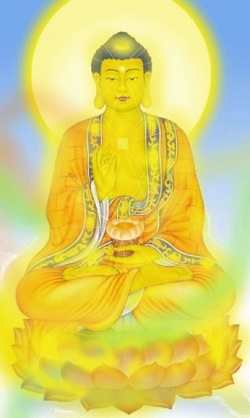Upanishads
- See Also in Wikipedia :
(Upanisad), Skt., lit. upa. “near,” ni: “down,” sad: “sit,” “to sit down near to,” that is, at the feet of the guru, in order to receive the confidential, secret teaching. The Upanishads form the final portion of the - shruti (the revealed part of the Veda) and the principal basis of - Vedanta, the philosophical conclusion derived from the Vedas. They are distinguished, valued highly by seekers of wisdom, for their transcendent breadth and powerful freedom of thought. Like creeping plants ( - valli), they lean against the preceding sections of the Veda to which they belong and yet preserve total independence and freedom from priestly dogma. Central to the Upanishads is the significance of atman and - brahman, knowledge of the identity of these two, and the meaning of the sacred syllable - OM.
Of the twelve most important Upanishads, the Aitareya and Kuashitaki belong to the - • Rigveda, the - Chandogya and - Kena belong to the - • Samaveda, the Taitlifiya, Katha, Shvetashvatara, Brihadaranya - ka, and Isha belong to the Yajurveda, and the Prashna, Mundaka, and Mandukya belong to the Atharvaveda.
Each of the four Veda was taught in various shakhas (“branches”), that is, Vedic schools. The older Upanishads were originally the dogmatic textbooks of the individual Vedic schools. However, the Upanishads of the Yajurveda and above all of the Atharvaveda no longer have any reference whatever to a particular Vedic school. The school of the Shvetashvatara-Upanishad, for example, is completely unknown, and the Upanishads of the Atharvaveda are apocryphal in character for the most part.
Each Shakha has its own Brahmana, to which an Aranyaka is appended that in turn contains the Upanishad. The Brahmana and Aranyaka arose with a view to the Brahmanic life stages ( ashrama, 2), according to which it fell to those in the second stage ( - i> grihasta) to carry out the sacrificial rites. For the third stage ( - vanaprastha) was reserved the process of internalization of these ceremonies. In the place of a physical sacrifice, which an older person often could no longer carry out, came the mental review of the deep, mystical meaning of the Veda. At this level, the man who had learned the Upanishadic text at the first stage ( - brahmacharya) was finally capable of understanding its profound insights into the nature of the world and one’s own self.
The teachings of the Upanishads are frequently clothed in stories. In many of these great sages visit the courts of kings, who become their pupils and ask for instruction in the way to discover the supreme truth.
